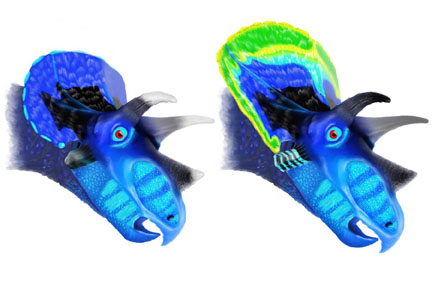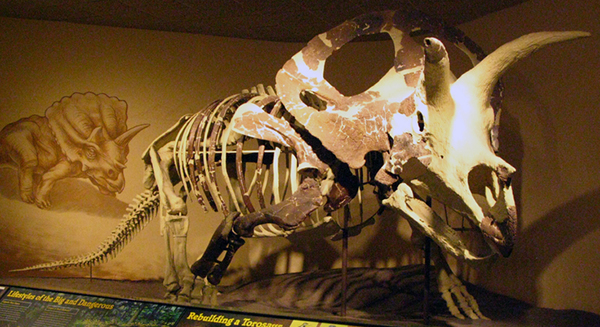
by Erin Wayman Thursday, January 5, 2012

_Triceratops_ (left) had a shorter frill than _Torosaurus_ (right). Artwork by Holly Woodwrad, Montana State University

_Torosaurus_ had giant holes in its frill. When the animal was alive, the holes were covered in a thin layer of keratin. Daniel Hendricks, Creative Commons Attribution-ShareAlike 2.0 Generic
Triceratops and its cousin Torosaurus are not hard to tell apart. Both horned dinosaurs had a giant bony frill that rose up behind the head, but Torosaurus’ frill was much longer and was adorned with giant holes that were covered by a thin layer of protein called keratin. Yet Triceratops and Torosaurus may have been more alike than scientists realized: New research suggests that the two animals were actually the same species, with Torosaurus being the adult version of Triceratops.
It’s not unprecedented for scientists to determine that what were previously classified as distinct dinosaurs were actually just different life stages of the same species. In the 1970s, Peter Dodson, a paleontologist at the University of Pennsylvania in Philadelphia, demonstrated this with duck-billed dinosaurs. Last year, paleontologists Jack Horner of Montana State University in Bozeman and Mark Goodwin of the University of California at Berkeley reported in PLoS ONE that two genera of dome-headed dinosaurs — Dracorex and Stygimoloch — were really just young members of Pachycephalosaurus.
Such misclassifications have happened because scientists haven’t always considered growth patterns and development when assessing dinosaurs, so it’s likely there are many more cases of mistaken identity out there, says John Scannella, a doctoral student at Montana State University and co-author of the new study, published in the Journal of Vertebrate Paleontology.
About 20 years ago, paleontologists John Ostrom of Yale University in New Haven, Conn., and Peter Wellnhofer of the Bavarian State Collection for Paleontology and Geology in Munich, Germany, first suggested Triceratops and Torosaurus might be members of the same species, Scannella says, with Torosaurus, the larger animal, actually being a male Triceratops and the smaller Triceratops being females. But no one had studied that possibility until now. Although Scannella and Horner, his advisor, agreed that these dinosaurs might be the same species, they thought the differences between Triceratops and Torosaurus were more likely the result of age than sex.
Over the past couple of years, Scannella and Horner traveled to museums across the country to examine more than a hundred Triceratops and Torosaurus specimens. They grouped the Triceratops skulls in their sample into different life stages based on certain features that scientists had previously determined changed as the animal got older. For example, the horns of a young Triceratops pointed backward; as the animal matured, its horns started to face forward. In looking at differences between the age groups, Scannella and Horner found that as a Triceratops aged, its frill elongated (approaching the length of Torosaurus) and the bone thinned out — specifically, the bone got thinner in the precise areas where Torosaurus had its holes. By studying the Torosaurus skulls, they also learned that Torosaurus had all the known signs of a mature Triceratops, such as forward-facing horns.
They further tested their idea by looking at the bones’ microstructure under the microscope. Older individuals have more bone remodeling, in which older bone is replaced with new bone, so older bone looks different than younger bone. The pair cut samples from the horns of several Triceratops and Torosaurus specimens, and noticed the Torosaurus skulls had more bone remodeling than the most mature Triceratops samples, indicating a more advanced age for the Torosaurus specimens. All of this evidence points to Torosaurus being an adult Triceratops, Scannella says.
If this is true, then it means Triceratops didn’t gain some of its adult traits — the longer frill and holes — until very late in development, as none of the largest (and presumably oldest) Triceratops possess the defining traits of Torosaurus. Such late blooming is not unheard of in the animal kingdom, Scannella says. An adult cassowary, for example, has a large bony crest on its head that develops suddenly at the end of the bird’s adolescence, he says.
“It’s a very creative hypothesis and they’ve got interesting data in support of it,” Dodson says. “I just have a hard time swallowing that the transformation would be that great.” He also points out that the fusion of sutures on Triceratops skulls suggest that some of the largest-known Triceratops were indeed fully grown, because such sutures don’t fuse until later in life in animals.
Andrew Farke, curator of paleontology at the Raymond M. Alf Museum of Paleontology in Claremont, Calif., also finds it hard to believe that Triceratops and Torosaurus were the same animal. One problem with the idea, he says, relates to the dinosaurs' epoccipitals, projections of bone that line the edges of the animals' frills. All species of horned dinosaurs had epoccipitals and the number stayed the same throughout an animal’s life. Triceratops had many more epoccipitals than Torosaurus, he says, so the new hypothesis would imply that as a Triceratops grew up, it lost some of its epoccipitals — that would be “unprecedented” among horned dinosaurs.
Still, Farke says, several characteristics of Triceratops are unusual compared to other horned dinosaurs, so anything’s possible. He says he’s not “unconvincible,” but needs to see much more data before he would be sold on the idea.
One valuable piece of data would be the discovery of a skull that exhibits transitional features between Triceratops and Torosaurus, says Michael Ryan, curator of vertebrate paleontology at the Cleveland Museum of Natural History in Ohio. That would make Horner and Scannella’s case even stronger, he says. “I think [they’re] probably correct … but we need more data.”
If Torosaurus and Triceratops are the same species, then the significance of the change goes beyond the need to update textbooks and museum exhibits, Scannella says. In recent years, in part due to the number of dinosaur species that have been consolidated because of misclassifications, paleontologists have noticed that dinosaur diversity started to decline during the Late Cretaceous, just prior to the asteroid impact 65.5 million years ago that killed off the dinosaurs. This work provides further evidence of that decline, Scannella says, and forces scientists to consider what caused dinosaurs to dwindle at this time.
It also changes the way scientists view dinosaur ecology, Scannella adds. If an area was once home to several species of very closely related animals, then scientists need to think about how the animals could have co-existed, in terms of sharing available food resources, for example. But if similar dinosaur species turn out instead to be babies, teenagers and adults of the same species, then the kinds of ecological questions scientists ask will be different, he says.
Finally, the work reminds us that paleontologists are far from knowing all there is to know about even the most iconic dinosaurs, Scannella says. “Even a dinosaur like Triceratops, which we’ve known about for 120 years, still has surprises in store for us and a lot to teach us about the history of life on this planet.”
© 2008-2021. All rights reserved. Any copying, redistribution or retransmission of any of the contents of this service without the expressed written permission of the American Geosciences Institute is expressly prohibited. Click here for all copyright requests.